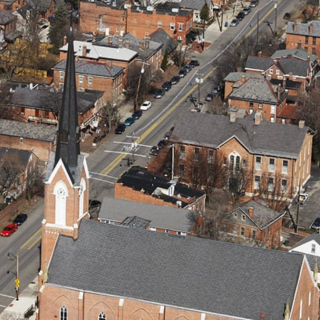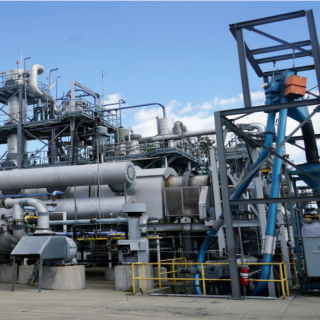What is described as the “crown jewel” and largest of local Metro Parks – the Battelle Darby Creek Metro Park – is being coveted by RAPID 5, which someday may build a brewery, the “Darby Inn” and a gondola within the park. Similar to the one at the Ohio State Fairgrounds, but several miles in length and built alongside the Big Darby Creek.
Far west, past Hilliard and just off Broad Street before the town of West Jefferson, sprawls the 7,000-plus acre Battelle Darby Creek Metro Park. Both the Big and Little Darby Creeks cut through this Metro Park, and both creeks in 1994 were designated as National Wild and Scenic Rivers, which affords them environmental protections.
The Big Darby Watershed is considered one of the most ecologically diverse in the US. Home to over 100 migratory birds, 50 species of fish and 90 species of freshwater mussels, which are “canaries in the coal mine” to the health of freshwater. The Big Darby had a large mussel die-off in 2016 and to this day no one knows why.
Launched in 2019, and now led by Ohio pandemic hero Dr. Amy Acton, RAPID 5 has serious designs on all five of Central Ohio’s major north-to-south waterways: The Big Darby, the Scioto River, the Olentangy River, Alum Creek and the Big Walnut. RAPID stands for “Rivers and Parks Imagination Design”.
Each of the five waterways travels through, in some cases, multiple Metro Parks. Such as the Big Darby, which also travels through nearby Prairie Oakes Metro Park.
To be clear, says RAPID 5 spokesperson Rochelle Young, the gondola and other ideas for Battelle Darby Creek Metro Park is not a “plan” but a “vision.” A conception that (hopefully) should come under serious scrutiny by the likes of the Ohio Department of Natural Resources, the Ohio EPA, and local conservancies.
“The gondola, the inn, as well as other ideas are part of a potential vision of the future,” said Young to the Free Press. “It is a look at what might be possible – it is not a plan or reflective of any current project taking place or currently moving forward.”
Either way, some fans of the Metro Parks are taking a subdued pause. Because RAPID 5’s “vision” appears determined on building mixed-use within the parks themselves, similar to what occurred at Columbus’s newest Metro Park, Quarry Trails.
To process what a local Metro Park integrated with mixed-use looks like, take a drive down Trabue Road. Emerging from the rubble of Quarry Trails is what appears to some as “Easton West.” Many Metro Park fans have told the Free Press the community was led to believe a world-class park would be built in the heart of Columbus with some mixed-used on the edges, and not the other way around.
Initially inspired by MORPC (Mid-Ohio Regional Planning Commission), RAPID 5 has transformed into a private and public partnership. Some of its biggest contributors are the City of Columbus, OSU, Thrive Companies (a major local developer), The Columbus Foundation, and ADS of Hilliard, or Advanced Drainage Systems, Inc., which announced this past summer a $65 million expansion in Hilliard.
Five different design firms were hired, one for each waterway. This public and private partnership has a “vision” to build “the largest, interconnected park system in the country by connecting central Ohio’s five major watersheds, abundant greenways, vibrant parks and paths; and, to become a region where every resident can access nature within a mile of their home.”
Some in the community will applaud a gondola stretching over lush Ohio forest, and at the end of the ride, some charcuterie with a chilled pinot grigio. But some long-time fans and volunteers of the Metro Parks aren’t seeing eye-to-eye with any gondola or pinot being served off trail.
“I have a very large axe to grind with Metro Parks management regarding RAPID 5,” said a dedicated volunteer and financial supporter who wished to remain anonymous. “I think Quarry Trails is horrible. And that seems to me a classic example of what RAPID 5 plans to do.”
Another fan of the Metro Parks, who also requested anonymity, says they are getting a “distinct impression” that high-end developers are whispering in ears of RAPID 5, telling them that local Metro Parks are potential gold mines.
“What they are planning on doing with new parks and all the changes they are doing to the current parks, is that they want to, with these developers, to turn these places into outdoor playgrounds to attract young professionals to these areas. And that’s what Quarry Trails is,” they said. “Condos and apartments built right on top of a Metro Park.”
They added: “This has absolutely nothing to do with the Metro Parks’ normal vision of doing things for the benefit of wildlife and making the parks places where regular people can enjoy wildlife and wild areas.”
Jane Beathard, a journalist from London (Ohio), which is not far from the Big Darby watershed, has been reporting on and advocating for the watershed for over a decade.
Unfortunately, says Beathard, it’s only logical why developers are lustful for this watershed.
“Columbus is growing to the west because it has already grown to the east – Reynoldsburg, Pickerington. It’s grown to the north, look at Delaware. And the chances of it ever grows to the south are slim to none. So the west is ideal,” she says. “Drive Route 40 (Broad Street) to West Jefferson, and you will see it. You will see the apartments and condos, and that the city is pushing to the west.”
But there are several thorns-in-the-side for developers who have (unnatural) desires for this prairie land and the watershed
“Of course the big obstacle to all of this are the Metro Parks (Battelle Darby and Prairie Oakes) and the Darbies, which are national and state scenic rivers and they have to be handled in a certain way,” says Beathard.
The Darby Creek Association (DCA), a small and barely funded non-profit, has been advocating for the Big Darby Watershed since 1972 and believed to be one of the oldest river conservation efforts in the nation.
DCA member Anthony Sasson said they met with RAPID 5 and Dr. Acton this past summer.
“We wanted to make sure they were aware of the potential impacts that some of their proposals could have on the scenic rivers. Both from an aesthetic standpoint and also a habitat degradation standpoint, meaning the area right along the creeks,” said Sasson. “They said they were aware of what our points were and to keep in touch.”
Sasson says RAPID 5 is just one of many “visions” by developers on the DCA’s radar over its history. The threats have been so significant the DCA helped pass The Big Darby Accord in 2006, an agreement with Franklin County to preserve the ecology of the Big Darby Watershed while providing direction for any possible growth. The accord states this prairie land, along with the Big Darby Watershed, is the most underdeveloped land in Franklin County.
The problem is, the Darby Accord protects just 15 percent of the watershed, and just the westsides of the Big and Little Darbies, and only in Franklin County. The eastsides are in the neighboring counties of Madison, Champaign, and the headwaters are in Logan.
“Developers (on the eastside of both creeks), as they would see it, have had their recent successes,” said Sasson, who attended 200 meetings to make the Darby Accord a reality.
Several years ago Kroger, for instance, was approved by West Jefferson officials to run a pipeline underneath both Darbies to service a future store near the banks of the Little Darby. The store has yet to be built and the pipeline will also serve a future apartment complex which was also approved by West Jefferson.
In Plain City (Madison County), adds Sasson, two recent and large developments “have been built right along the creek”. And another Plain City development – “at a huge level,” he says – has been proposed.
In Logan County, near the headwaters or where the Big Darby Creek begins, a proposal for a potential 20,000-unit development is in the works.
What protections from developers does the National Wild and Scenic River designation give to the Big and Little Darby Creeks?
“It’s actually pretty limited,” said Sasson. “For some jurisdictions it’s only within 1,000 feet.”
The Free Press has heard from developers themselves: For many projects, it’s either feast or famine, depending on what’s being built and the land its being build on, they’ve told us.
“The developers like to promote areas that have natural features close to the development,” Sasson says. “That is a big positive for them because it could even add to the value and selling point for those places.”
Sasson then chuckles, saying, “Local governments don’t have experts in some of these areas (i.e., river conservancy). They may take what the developers give them, and developers aren’t necessarily aware of all the impacts they are proposing could have.



